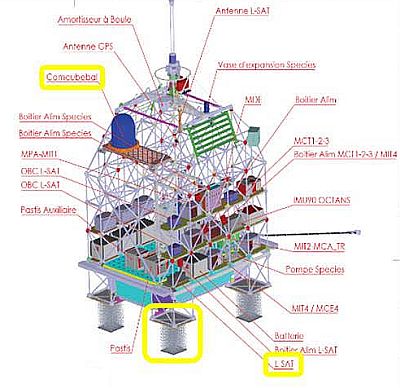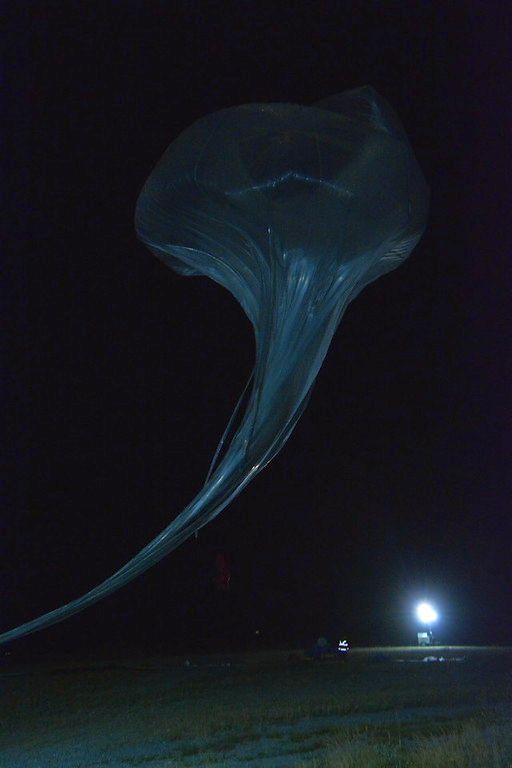Purpose of the flight and payload description
The Pre-TRANSAT mission was the fourth and last flight of the Strato Science 2023 campaign aimed to test a series of subsystems to be used in a transatlantic balloon flight to be carried out by the Centre National d'Etudes Spatiales (CNES) from Sweden to Canada in 2024. Adittionaly, several experiments were also included in the gondola. At left we can see an scheme of distribution of the payloads in the gondola (click to enlarge).
It used as platform CARMENCITA a multi-payload stabilized gondola originally introduced in late 2012 by the Nacelles Pointees (Pointed Platforms) CNES team, which was developed with several concepts in mind: modularity to allow the inclusion of several instruments devoted to the same or different research areas in one mission, reusability to overcome the difficult to adapt a platform specifically designed around an instrument to another (reducing costs and developing times), and finally cargo volume which is maximized to allow the installation of many instruments.
Onboard the gondola were installed the following instruments:
SPECIES an instrument developed by the Laboratoire de Physique et Chimie de l'Environnement et de l'Espace (LPC2E) and the Laboratoire interdisciplinaire de Physique (LIPHY). It is able to measure a wide variety of trace gases simultaneously (e.g. O3, N2O, HNO3, NH3, H2O2, HCl, HOCl, CF2O, CH4, CH2O, CO, CO2, OCS, SO2) with a wide vertical range, combined to chemical and dynamical modelling at different scales. It was born in order to replace another instrument called SPIRALE developed by LPCE but which can no longer fly. LPC2E along with CNES developed SPECIES based on the Optical Feedback Cavity Enhanced Spectroscopy (OF-CEAS) technique combined with mid-infrared quantum or interband cascade lasers (QCLs or ICLs). The instrument is usable both in balloon or aircraft and on the ground to optimize its exploitation.
CALASET acronym for Canadian Atmospheric Laser Absorption Spectrometer Experiment Test-bed, a collaborative project between University of Toronto and University of Alberta to design laser spectrometers for stratospheric balloon flight. Instruments are constructed to be both highly sensitive and mechanically robust. The first generation of CALASET is an infrared laser spectrometer built for in-situ sensing of CO2 and N2O on a stratospheric balloon gondola. Wavelength modulation spectroscopy (WMS) techniques are used to collect and visualize spectra during flight and to perform post-flight analysis.
A prototype of COMCUBE a space mission project, composed of several CubeSats, each containing a Compton telescope capable of measuring the polarization of gamma rays. It was developed by the Laboratoire de Physique des 2 infinis Irène Joliot-Curie of the Université Paris-Saclay.
Finally were included two technological developments from CNES L-SAT consisting of a new Iridium communication module with the aim of testing satelite communication for payload gondola and MEDOR a retractable renewable energy system, solar generator which was located below the gondola to power experiments during long-duration flights.
Details of the balloon flight
Balloon launched on: 8/27/2023 at 7:12 utc
Launch site: Timmins Stratospheric Balloon Base, Ontario, Canada
Balloon launched by: Centre National d'Etudes Spatiales (CNES)
Balloon manufacturer/size/composition: Zero Pressure Balloon model 400z Hemeria 400.000 m3
Flight identification number: NIMBUS-4
End of flight (L for landing time, W for last contact, otherwise termination time): 8/27/2023 at 21:42 utc
Balloon flight duration (F: time at float only, otherwise total flight time in d:days / h:hours or m:minutes - ): 14 h 30 m
Landing site: 30 km WNW of Timmins, Ontario, Canada
External references
- Information on the Strato Science 2023 balloon launch campaign Canadian Space Agency website
- PHOTOS: What is object seen floating above Batchawana Bay? Saulte St. Marie news
- Retour sur la campagne Strato-Science 2023 CNES website
16336If you consider this website interesting or useful, you can help me to keep it up and running with a small donation to cover the operational costs. Just the equivalent of the price of a cup of coffee helps a lot.







